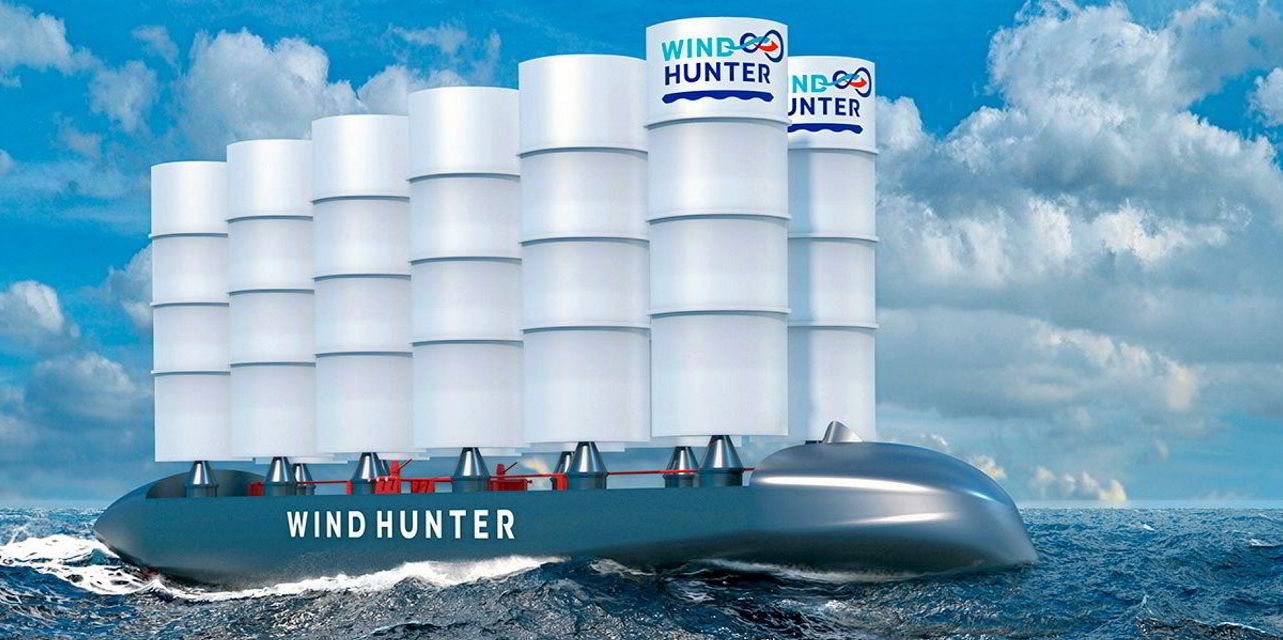What if it did not matter how fast a ship delivered cargo to its destination? What if, instead, the ship’s trajectory was focused on seeking out the clean energy that would allow it to ensure a zero-emission voyage?
That, according to Mitsui OSK Lines executive officer Makoto Yamaguchi, is one of the goals of the Wind Hunter — a vessel concept that the Japanese shipping giant is pursuing with partners.
“It can be called the ultimate zero-emission ship,” he told Green Seas.
The executive, who is responsible for MOL’s technical and smart shipping divisions, has launched a feasibility study with its engineering partner and various shipbuilders to explore a 60 to 70-metre-long vessel that will have large hard sails to harness wind power and produce hydrogen on board, which would be used to propel the ship when there is less wind.
Yamaguchi described the concept as a “ship-shape hydrogen producer” that moves freely across the oceans to find ideal wind energy.
The vessel could serve two purposes: one version could be a zero-emission cargo ship, and another could work as a mobile hydrogen supplier that could deliver green fuel around the world.
As the sails push it forward, the vessel uses submerged turbines to power an electrolyser, which uses water to produce hydrogen. The fuel is stored in the form of methylcyclohexane, a compound known as MCH that can hold far more hydrogen in the same storage area than hydrogen gas. And unlike compressed or liquefied hydrogen, it can be stored without cryogenic equipment or pressurisation.
Asked why not use batteries instead of hydrogen production, Yamaguchi said there are pros and cons of energy storage options — and the cons of batteries are the weight and space needed for long-haul shipping, which made for challenging economics.
Construction starts next year
The goal is to start construction of a pure emissions-free ship in 2024.
Yamaguchi said the Wind Hunter should be able to carry conventional cargoes, but he added that MOL will need to prove the case first by carrying out several voyages with the ship.

Yamaguchi acknowledged that a ship driven in this way, rather than travelling quickly from one point to another, will require an evolution in the way society sees shipping’s value chain.
He said MOL envisions a future in which the value of zero-emission shipping has priority over “speedy cargo transportation”.
But is a vessel that chases wind to produce its own fuel an unrealistic proposition?
Lucy Gilliam, senior shipping policy officer at environmental non-governmental organisation Seas at Risk, does not think so.
“The separate different innovations that are in that project are quite well known,” she said. “The rigging, the wind propulsion, the energy-generating propeller, the hydrogen — those are things that are quite technology ready. The innovation is sticking them all together.”
Yacht trials
As TradeWinds has reported, MOL first carried out a pilot project using a sailing yacht outfitted with generators to produce hydrogen and drive propulsion.
Yamaguchi said the results of the test were successful, providing valuable lessons for the next phase of the project.
One thing Tokyo-based MOL has learned is that there remain gaps in hydrogen technology and rules for using it at sea, compared to land-based use of the fuel.
There still is work to be done to investigate the efficiency of the vessel’s planned components, and he said new technologies are under development, including an optimised arrangement for the telescopic hard sails. MOL is also developing an underwater generator turbine that will both produce hydrogen in high winds and propel the vessel when those winds die down.
A Wind Hunter focused on hydrogen supply, rather than cargo shipping, would spend more of its time chasing strong winds to stay in production mode, rather than expend its fuel.
Yamaguchi said MOL is working with makers of a technology known as Doppler Lidar to allow the vessel to hunt the best wind, as well as technologies that will provide accurate weather forecasting.
The ship it plans to build from 2024 will be for demonstration purposes and for further investigation before developing a Wind Hunter for commercial use.
Yamaguchi said Wind Hunters could operate commercially around 2030.
“The voyage with the wind sail is like the Age of Discovery, but it is modernised by means of the latest technology to make the voyage sustainable and effective,” Yamaguchi said.





